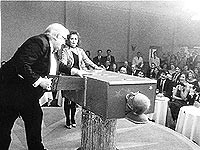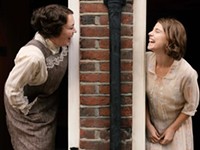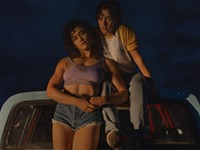Also playing...
[
{
"name": "500x250 Ad",
"insertPoint": "5",
"component": "15667920",
"parentWrapperClass": "",
"requiredCountToDisplay": "1"
}
]
Of all the major artistic movements of the 20th century, surrealism may be the one modern filmmakers find the most inimitable. With its roots in the often incongruous works of French poets Robert Desnos and Paul Eluard, it should come as no surprise that the one true purveyor of the movement in film might be Jean Cocteau. Until now.
Swedish filmmaker Roy Andersson's film, Songs from the Second Floor, is a surrealist's dream from its opening shot to its very last words. Presented as a series of seemingly countless, usually unrelated tableaux, Andersson evokes Salvador Dali and Rene Magritte in every frame and Kafka in every absurd, relentlessly harsh line.
Set in an unidentified Scandinavian city, on the verge of the Y2K (the film originally had limited theatrical release in 2000), Anderson brings his surrealistic sensibilities together with a deeply understood sense of satire and slapstick comedy. The result is a commentary on the possibilities posed by the computer glitch that are unlike what anyone, in even the most mentally distended state, could imagine.
Strung together as a series of vignettes, each one of Andersson's stories seems a highly exaggerated take on a city that is in serious danger of coming both literally and philosophically to a full stop. A desperate man, recently fired, clings to the leg of his boss, who drags him down a corridor. Another man slowly goes mad from a guilty conscience after he willfully burns his furniture store to the ground for the sole purpose of collecting insurance money.
When a room full of executives insists it sees a building across the street move, the ensuing mad rush to escape is all too evocative of the panic many were convinced would sweep the planet. (Incidentally, if ever faced with that prospect just remember Andersson's simple, hilarious solution: The door opens in).
Perhaps the most effective element of Andersson's storytelling is his decision to use a static, unmoving camera to film each essentially implausible scene. While the believability of each story is debatable, Andersson keeps the audience on the balance between reality and fantasy. By composing each action within the viewfinder of his camera and keeping it a fair distance from his brilliant cast of actors --- which dazzles uswith deadpan performances rather than with good looks --- Andersson creates a hugely successful paradox.
Without the usual zooms, pans, and dollies, the viewer gets a fly-on-the-wall vantage point. These commonly used filmmaking techniques often serve to create a false sense of inclusion for the audience. However, by watching the scene as it unfolds in Andersson's viewfinder, instead of being jerked around by various editorial cuts, the action achieves a level of believability. And that, given the circumstances, is a remarkable feat.
Songs from the Second Floor screens Tuesday, January 18, at the Dryden Theatre, in the George Eastman House, 900 East Avenue, at 8 p.m. 271-4090, www.eastmanhouse.org
--- Christopher Nakis and Katie Papas
Speaking of Songs From The Second Floor
-

Swedish surrealism via Peru and Python
Jul 31, 2002 - More »





